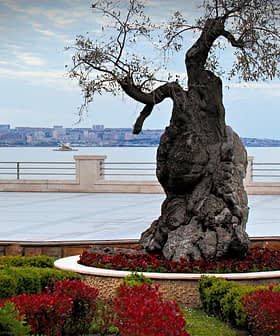The future is looking a healthy green, olive green actually, for the Golden State’s olive oil makers in light of the USDA’s recent revision of olive oil grading standards. Effective October 25, 2010, all olive oils will have to conform to industry standards commonly accepted in the US and abroad. The new standards will provide a common language for trade and provide consumers more assurance of quality in the olive oil they buy, a boon for California makers and consumers alike.
The new standards will affect importers and the more than 500 domestic growers and producers by ensuring uniformity and consistency in commercial olive oil. The US has had no definition for the varying quality grades of olive oil, leaving an open door for unscrupulous blenders to market low quality oils, label them extra virgin, and sell at a premium price. The new standards set a defining language in place that will facilitate the marketing of olive oil, encourage truth in labeling, and provide a basis of enforcement if mislabeled.
The California Olive Oil Council (COOC) filed the petition with the USDA in August 2005 to adopt a standard, especially for extra virgin olive oil. Executive Director, Patty Darragh says it’s “been a long journey for us.” The COOC is over 200 members strong in the state that produces more than 99% of the nation’s olive oil. Members have met all requirements for COOC Seal Certification for True Extra Virgin Oil, which entail strict testing including extraction method, free oleic acid level, and taste elements.
 Standards set by the USDA are now consistent with International Olive Oil Council standards. COOC Seal Certification standards are higher. For example, COOC requires no more than .5% free oleic acid, whereas the new standards will require oils to be no more than .8%. COOC member, Jeanne Coldani of Coldani Olive Ranch says members “meet better than that standard.” Coldani’s Calivirgin brand has better than .1%. Though the new standards won’t affect COOC members, Coldani is hopeful they will raise awareness of what is on the shelves. “California can’t compete with the pricing on the imports,” she says. The US market is flooded with oils produced from unscrupulous blenders. They are mislabeled to attract the consumer. For years producers have claimed their oils, without repercussion, as extra virgin when they may be no more than 10% olive oil.
Standards set by the USDA are now consistent with International Olive Oil Council standards. COOC Seal Certification standards are higher. For example, COOC requires no more than .5% free oleic acid, whereas the new standards will require oils to be no more than .8%. COOC member, Jeanne Coldani of Coldani Olive Ranch says members “meet better than that standard.” Coldani’s Calivirgin brand has better than .1%. Though the new standards won’t affect COOC members, Coldani is hopeful they will raise awareness of what is on the shelves. “California can’t compete with the pricing on the imports,” she says. The US market is flooded with oils produced from unscrupulous blenders. They are mislabeled to attract the consumer. For years producers have claimed their oils, without repercussion, as extra virgin when they may be no more than 10% olive oil.
The expectation among makers says Darragh, is that “these standards and legal definitions will serve notice to unscrupulous importers so there will be less mislabeled and adulterated product.” The documents will provide legal reference of definition for any government agency to enforce. The USDA, which has six months to set regulations and put testing into place, has wasted no time. A chemical testing lab has been in place for a year now in preparation for the passing of these standards and a taste panel is being trained to blind taste olive oils for defects.
The UC Davis Olive Center has been at the helm of olive oil education, research, and outreach for more than a century. It had a hand in California’s labeling legislation and provided technical support to the COOC’s drafting of the petition for the new standards. In response to the new USDA grade standards, Executive Director Dan Flynn says, “It’s a big step forward, for the first time we’ll have the federal government looking out for olive oil quality. Greater attention will be paid to what extra virgin really means.”
 Educating the consumer is vital for the standards to be effective. Dewey Lucero of Lucero Olive Oil, knows the value of an educated consumer “The US public has been trained to like bad olive oil,” he says, but he believes the new standards can change that. Jeanne Coldani agrees, saying “The more educated the consumer the better it is for the grower because people will want fresher oil.” One way to ensure high quality olive oil is a COOC certification. A member himself, Lucero says, “We produce some of the best oil in the world and one of the biggest reasons is because it’s fresh. It’s right in your backyard.” He is confident that once the public gets a taste of California’s offerings, it will “start to recognize good olive oiland will push the industry to produce more high quality oils.”
Educating the consumer is vital for the standards to be effective. Dewey Lucero of Lucero Olive Oil, knows the value of an educated consumer “The US public has been trained to like bad olive oil,” he says, but he believes the new standards can change that. Jeanne Coldani agrees, saying “The more educated the consumer the better it is for the grower because people will want fresher oil.” One way to ensure high quality olive oil is a COOC certification. A member himself, Lucero says, “We produce some of the best oil in the world and one of the biggest reasons is because it’s fresh. It’s right in your backyard.” He is confident that once the public gets a taste of California’s offerings, it will “start to recognize good olive oiland will push the industry to produce more high quality oils.”
Integrity, high standards and passion have driven California olive oil makers to produce quality oils for years. Now that the USDA has revised their grading standards, the competition will be leveled at the marketplace and consumers will soon experience a whole new taste of olive oil.








